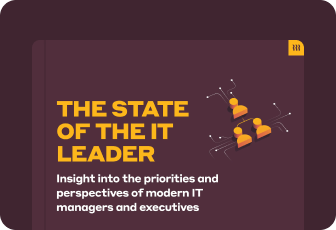Endpoint security refers to the protection of devices like computers, smartphones, and tablets from cyber threats, ensuring that these endpoints are secure from unauthorized access and data breaches. It is a critical component of an organization's overall cybersecurity strategy.
What is an endpoint and why secure it?
But first, what is considered an endpoint? The simplest definition is any device that connects to your organization’s enterprise network and can send or receive data. Common examples include:
- Desktops and laptops
- Smartphones and tablets
- Servers and workstations
- Internet of Things (IoT) devices (smart watches, appliances, cameras, printers, etc.)
When it comes to endpoints, there’s a wide range of hardware platforms with which to contend. However, this hardware diversity doesn't just create headaches for IT admins and security teams, it's also a golden opportunity for threat actors.
Think about it from the attacker's perspective: Every new device category represents another potential gateway to infiltrate your network. Each category has its own unique vulnerabilities and attack vectors, such as unpatched web apps on servers, phishing emails that trick employees into installing malware on their laptops, or smart TVs with hard-coded default passwords that hackers can exploit to pivot into your corporate network.
The more endpoints and complexity in your network, the harder it becomes to maintain consistent security across all your assets. As the traditional network perimeter dissolves and employees increasingly work from anywhere, organizations are realizing that the old castle-and-moat approach to cybersecurity just doesn't cut it anymore.
In the castle-and-moat approach, the focus is on securing the network perimeter (the "moat") to protect internal resources (the "castle"). However, once an attacker breaches the perimeter, they can easily move laterally within the connected network and inflict havoc. This is unlike MDM solutions in which each device is managed individually, meaning that if one device is compromised, it doesn't necessarily impact the entire fleet of devices.
That's where endpoint protection solutions come in as a proactive, multi-layered strategy to secure every end-user device touching the corporate ecosystem.
What is endpoint security?
Endpoint security refers to the practice of protecting devices connected to a network from malicious activities and unauthorized access. You can think of it as a bouncer at a club. It's there to make sure only authorized people (or in this case, devices and applications) get in and to keep the troublemakers out.
The key components of endpoint security include:
- Anti-malware or antivirus software: This basic protection scans devices for known malware and viruses, finding and removing any detected cybersecurity threats. It serves as the first line of defense against common cyber attacks.
- Next-generation antivirus (NGAV): NGAV improves upon traditional antivirus by using techniques like behavioral analysis and machine learning. These tools can find and stop new and unknown threats, providing better overall threat protection.
- Firewall and application control: A firewall is a barrier that controls incoming and outgoing network traffic. It analyzes data packets and blocks any suspicious access attempts. In other cases, users might try to install applications that aren't approved by IT. Application control helps you prevent that and keep your devices safe.
- Mobile device management (MDM): With the increasing use of smartphones and tablets for work purposes, alongside the growing popularity of bring-your-own-device (BYOD) practices, MDM solutions have become essential. These tools allow organizations to secure, monitor, and manage mobile devices, ensuring that they adhere to corporate security policies.
- Vulnerability management: This involves regularly scanning devices and applications for potential weaknesses or vulnerabilities. By finding and prioritizing these security gaps, organizations can quickly fix or address them before attackers can take advantage of them.
- Access control and privilege management: These security measures ensure that users only have access to the resources and data necessary for their specific roles. By implementing the principle of least privilege and carefully managing user permissions, organizations can minimize the risk of unauthorized access and data breaches.
- Intrusion prevention system (IPS): An IPS is a network security tool that continuously monitors network traffic for suspicious activities. It can detect and prevent potential security threats, such as unapproved access attempts, malware propagation, and network-based exploits, by analyzing traffic patterns and identifying anomalies.
- Data loss prevention (DLP): DLP solutions help organizations protect sensitive data from unauthorized access, use, or transmission. These tools can monitor and control data movement across endpoints, networks, and storage systems, ensuring that confidential information is not accidentally or intentionally leaked outside the organization.
While these components form a solid foundation for endpoint security, the ever-evolving threat landscape presents new challenges. Cybercriminals are constantly developing more sophisticated attacks, such as fileless malware, which are designed to evade traditional antivirus detection. These stealthy threats operate entirely in a device's memory, leaving no traces on the hard drive, making them difficult to detect and eliminate using conventional methods.
As a result, relying solely on antivirus software and other traditional endpoint security measures may not be sufficient to protect against advanced threats. This is where EDR comes into play.
What is EDR and how does it work?
Endpoint Detection and Response (EDR) is a more proactive approach to endpoint security. Instead of just relying on signature-based detection to identify known threats, EDR uses a combination of behavioral analysis, machine learning, and continuous monitoring to spot suspicious activity and potential threats in real time. This holistic, behavior-based approach allows EDR solutions to effectively detect and block novel attacks and fileless techniques that would otherwise evade traditional antivirus defenses.
Here's how it works:
- Data collection: EDR agents are installed on your endpoints, where they continuously collect data on all the activity happening on those devices—running processes, network connections, file changes, user behavior, etc.
- Analysis: All that data is then sent back to a central platform where it's analyzed using machine learning algorithms and other advanced techniques. This helps identify any patterns or anomalies that could indicate a potential threat.
- Detection: If the EDR system spots something suspicious, it flags it for further investigation. This could be anything from a process that's behaving oddly to a user account that's suddenly accessing sensitive data they shouldn't be.
- Response: Once a threat is confirmed, EDR can automatically take action to contain and mitigate the damage. This could involve things like isolating the infected device from the network, terminating malicious processes, or even rolling back changes made by the attacker.
- Investigation: EDR also provides security teams with detailed forensic data that can help them investigate an incident, understand how the attack happened, and identify any other devices or systems that may have been compromised.
What are the benefits of EDR?
EDR offers several key advantages which include:
- Better threat detection: With its advanced behavioral analysis and machine learning capabilities, EDR can identify threats that traditional antivirus might miss, including zero-day exploits, ransomware, and insider threats.
- Faster response times: Because EDR is continuously monitoring your endpoints in real-time, it can detect and respond to threats much faster than manual processes. This can help minimize the impact of an attack and reduce downtime.
- Reduced false positives: By using intelligent analysis techniques, EDR can help reduce the number of false positives (i.e., benign events that get flagged as threats) compared to signature-based antivirus. This means your security team can focus on real threats instead of chasing ghosts.
- Detailed forensics: EDR captures a wealth of data about endpoint activity, which can be invaluable for incident investigation and forensics. This data can help you understand how an attack happened, what systems were affected, and how to prevent similar incidents in the future.
- Compliance support: Many industries have strict regulations around data protection and security incident reporting (think SOC 2, HIPAA, PCI DSS, GDPR). EDR can help you meet these requirements by providing detailed audit trails and evidence of your security controls.
Understanding the differences between EDR, MDR, and XDR
As the importance of endpoint security has grown, so too has the array of solutions designed to protect these critical assets. Among the most prominent are Endpoint Detection and Response (EDR), Managed Detection and Response (MDR), and Extended Detection and Response (XDR). But what exactly are the differences between these three solutions?
Endpoint Detection and Response (EDR)
EDR is all about monitoring endpoint devices for signs of foul play. Where antivirus scans for known malicious files, EDR looks for suspicious behaviors and activities. The "R" in EDR is for response— this means that EDR doesn't just alert you to danger; it can actively contain it. If an endpoint starts acting shady, EDR can automatically quarantine it from the network to short-circuit an attack before it causes real damage.
EDR also continuously records endpoint activity to provide an audit trail for incident response. This is incredibly valuable for understanding the scope and timeline of a breach. You really don't want to discover an intrusion but have zero visibility into when it started or what the attacker might have accessed. Uncertainty is the enemy in incident response.
Managed Detection and Response (MDR)
This is basically EDR as a service. Instead of having to manage the whole EDR process yourself, you outsource it to a team of security experts who handle everything for you from monitoring and analysis to incident response. This can be a good option if you don't have the in-house expertise or resources to manage EDR on your own.
The whole point of this team of skilled security experts is to effectively analyze and interpret the vast amount of alerts and data generated by EDR solutions. The ideal scenario is one in which your MDR partner filters out the noise, prioritizes genuine threats, and delivers clear, actionable recommendations. However, it is important to note that the quality of MDR services can vary significantly between providers. While some MDR partners truly integrate with your team and offer detailed, context-rich reports that substantially reduce your workload, others may fall short of this standard.
Extended Detection and Response (XDR)
This takes things a step further by combining EDR with other security technologies like network analysis, SIEM, and threat intelligence to give you an even broader and more integrated view of your security posture. It's like having a whole team of security agents working together to protect your organization from every angle.
Where EDR myopically focuses on endpoints, XDR broadens its horizons. It stitches together data from multiple sources–endpoints, but also networks, servers, email, cloud services, etc.–into a more cohesive picture.
Choosing the right EDR solution for your organization
When it comes to protecting your organization's endpoints from cyber threats, choosing the right EDR solution is crucial. But with so many options out there, how do you choose the right one for your organization? Here are a few key things to consider:
- Detection capabilities: You want an EDR solution that can identify a wide range of threats, not just known malware, but also fileless attacks, zero-day exploits, and other advanced tactics. Look for a solution that uses multiple detection techniques, such as behavioral analysis, machine learning, and threat intelligence.
- Response automation: A good EDR solution should be able to automatically contain and mitigate threats as soon as they're detected, without requiring manual intervention. This can help minimize damage and reduce the workload on your security team.
- Ease of use: EDR can be complex, so you want a solution with a user-friendly interface that makes it easy to monitor endpoints, investigate incidents, and take action when needed. Look for features like customizable dashboards, alert prioritization, and guided incident response workflows.
- Scalability: As your organization grows and evolves, you need an EDR solution that can scale with you. Look for a solution that can handle a large number of endpoints across various operating systems and devices and can easily integrate with your existing security tools and workflows.
- Vendor support: Choosing an EDR solution is like entering into a partnership with the vendor. You want a vendor with a strong reputation for quality, reliability, and customer support. Look for things like 24/7 support, regular software updates and threat intelligence feeds, and a clear product roadmap.
- undefined
Frequently asked questions
How does endpoint security work?
Endpoint security works by installing lightweight agent software on each device to monitor activity, analyzing things like running programs, network traffic, and file changes for any suspicious behavior. When threats are detected, these tools can block the activity and alert IT security for further investigation. Endpoint security can be managed centrally through on-premises systems or cloud-based platforms, with the Endpoint Protection Platform (EPP) market leveraging a SaaS management console to communicate with endpoint agents and enable offline protection.
What's the difference between EDR and EPP?
EPP, or Endpoint Protection Platform, is basically the modern version of antivirus software. It focuses on preventing malware infection using techniques like signature matching, heuristics, and behavioral analysis. EDR goes a step further by continuously monitoring and logging endpoint activity to detect and investigate threats that may evade initial prevention, while also enabling active threat hunting and automated or guided response actions. Many modern endpoint security tools combine EPP and EDR into a unified agent and platform.
What's the difference between endpoint security and antivirus?
Antivirus is a subset of endpoint security that focuses specifically on detecting and blocking malware, traditionally relying heavily on signature-based scanning of files on disk. Endpoint security is a broader category that includes antivirus but also covers other threats like fileless attacks, insider abuse, and living-off-the-land techniques that don't involve malware, using behavioral monitoring and analytics in addition to signatures to catch stealthier threats. Essentially, endpoint security solutions pick up where legacy AV leaves off, providing more holistic protection, detection, and response across an organization's device fleet.
Rippling and its affiliates do not provide tax, accounting, or legal advice. This material has been prepared for informational purposes only, and is not intended to provide, and should not be relied on for tax, legal, or accounting advice. You should consult your own tax, legal, and accounting advisors before engaging in any related activities or transactions.

















































































































